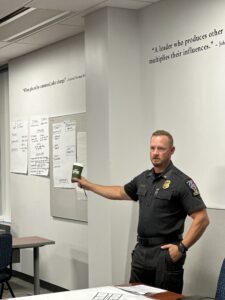In recent years, medical facilities have experienced an uptick of threats and violent events.[1] Within this increased threat landscape, it is imperative that medical facilities and emergency response agencies jointly prepare for active assailant incidents. The Maryland-National Capital Region Emergency Response System (MDERS) facilitated a Tabletop (TTX)-In-A Box with partners from MedStar Montgomery Medical Center (MMMC), Montgomery County Fire and Rescue Services (MCFRS), Montgomery County Office of Homeland Security and Emergency Management (OEMHS), and Montgomery County Police Department (MCPD). The exercise was designed to examine the initial actions of each participating entity and their ability to establish a Unified Command (UC)  during an active assailant incident. This exercise will help bolster the response capabilities for each discipline to respond to an active assailant incident in a medical setting.
during an active assailant incident. This exercise will help bolster the response capabilities for each discipline to respond to an active assailant incident in a medical setting.
To test each discipline’s response capabilities, participating agencies determined that a discussion based TTX would be the best approach. MDERS’s TTX-In-A-Box program is a systematic, scalable, and economical approach for developing and enhancing critical capabilities that foster interdisciplinary and interjurisdictional collaboration and coordination. The tool consists of a portable kit containing all materials required to run the hybrid exercise. For these exercises, work groups are formed and comprised of subject matter experts (SMEs) from relevant disciplines. In this exercise, the work group consisted of SMEs from MMMC, MCFRS, OEMHS, and MCPD. The work group provided invaluable input to craft a scenario to test the participants’ ability to adequately respond to an active assailant incident occurring in a hospital setting.
Eleven participants served as players during the exercise and were joined by over 45 observers. The exercise was guided by injects from a master scenario exercise list (MSEL) to simulate a realistic, continuous flow of information. Participants had to sift through pertinent and irrelevant information to determine the appropriate response in a dynamic situation. In the early stages of the exercise, each entity was responding within the framework of their discipline-specific policies and plans. As the scenario progressed, the entities formed a UC to make collaborative decisions and delegate tasks to the appropriate agency.
Overall, this exercise produced useful conversations about communication channels between participating agencies, triage care to victims, establishing a unified command, positioning of fire and police staging areas, dissemination of information to the public, reunification processes, reestablishment of healthcare within the facility, and patient movement to other healthcare facilities. These conversations will continue between partners to resolve identified gaps to enhance response operations.
MDERS remains committed to providing ongoing exercise support to our stakeholders in Montgomery and Prince George’s Counties. These exercises are tailored to bolster response capabilities and fortify the resilience of our communities. Through these ongoing efforts, our goal is to ensure readiness and efficiency in handling emergencies while safeguarding the well-being of our residents.
[1] Glatter, R., & Papadakos, P. (n.d.). The Epidemic of Violence in American Hospitals [Review of The Epidemic of Violence in American Hospitals]. Time.com; Time. Retrieved February 13, 2024, from https://time.com/6337450/the-epidemic-of-violence-in-american-hospitals/.












 The course then transitioned to basic medical education. Participants were taught about indicators of severe blood loss and the ramifications of major, life-threatening bleeding. Potential signs of life-threatening bleeding include but are not limited to blood spurting from the wound, blood pooling on the ground, and clothes soaked with blood. A victim exhibiting any of these symptoms needs immediate medical care.
The course then transitioned to basic medical education. Participants were taught about indicators of severe blood loss and the ramifications of major, life-threatening bleeding. Potential signs of life-threatening bleeding include but are not limited to blood spurting from the wound, blood pooling on the ground, and clothes soaked with blood. A victim exhibiting any of these symptoms needs immediate medical care.










